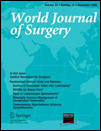Pheochromocytoma in MEN 2A Syndrome. Study of 54 Patients
Abstract
Background
Pheochromocytoma occurs in nearly 50% of MEN 2A (multiple endocrine neoplasia, type 2A) cases. Many issues related to this tumor are still the subject of debate: the diagnostic management in patients who have had positive genetic study results (RET mutation), variations related to mutation, the best surgical option, and the real relapse rate during long-term follow-up. The aim of this study is to present our experience with this unusual disease, looking for answers to some of these questions.
Patients and methods
Of 169 patients belonging to 19 MEN 2A families, 54 (32%) presented with pheochromocytoma. The following variables have been studied: (1) clinical and diagnostic data [age, mutation, clinical features, results of catecholamines and catabolites in a 24-h urine sample, computerized tomography (CT) scan and iodine-131 meta-iodobenzylguanidine (MIBG) scintigraphy results, and the means of diagnostic, clinical, or genetic screening]; (2) surgical treatment; and (3) follow-up and recurrence. The mean follow-up time was 92.5 months (range: 12–120 months).
Results
The mean age of the 54 patients was 37.9 years (range: 14–71 years); 33 were women. Most (96.3%) mutations were found in exon 11. The most frequent mutations were Cys634Tyr (in 33 cases [61.1%]) and Cys634Arg (in 14 [25.9%]). The diagnosis of pheocromocytoma was made after the diagnosis of MTC in 26 cases (48.2%), simultaneously in 21 (38.9%), and prior in the 7 remaining cases (12.9%). At the time of diagnosis 28 patients (51.8%) were asymptomatic and 26 (48.2%) had clinical features related to pheochromocytoma. In 6 patients (11.1%), the values of catecholamines and catabolites in urine were normal. In the cases with high values, the most useful isolated determination was that of metanephrines (82%), followed by adrenaline (76%). The CT scan did not provide a correct diagnosis in 6 patients with bilateral lesions, and one patient with a bilateral tumor was not diagnosed by MIBG. The combination of CT scan and MIBG diagnosed 100% of cases. The pheochromocytoma was bilateral in 27 cases, with a total number of 81 pathological glands detected. A laparascopic approach was used in 30 cases and a laparotomy in 24. The mean tumor size was 4.5 cm (range: 1–18 cm). Five patients with unilateral resection relapsed (18.5%), and the mean relapse time was 43.2 months (range: 12–120 months). There was a greater frequency of pheochromocytoma in those subjects who had the Cys634Arg mutation (p < 0.03). In addition, the Cys634Arg mutation is more frequent in bilateral cases. There are no prognostic factors for recurrence.
Conclusions
Pheochromocytoma in MEN 2A is related to the type of mutation, which can be early onset and is frequently asymptomatic. Its diagnosis requires catecholamines determinations as well as a CT scan. Correct diagnosis of bilaterality is established by CT and MIBG. Laparoscopic adrenalectomy is the treatment of choice.




